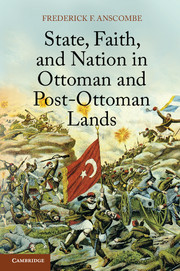Book contents
- Frontmatter
- Dedication
- Contents
- List of Maps and Images
- Acknowledgments
- Transliteration and Abbreviations
- Maps
- Introduction
- Part I The Ottoman Empire
- Part II From Ottoman to Post-Ottoman States
- Part III Contemporary Post-Ottoman States
- 9 The Contemporary Balkans
- 10 Contemporary Turkey
- 11 Contemporary Arab Countries
- Conclusion State, Faith, and Nation
- Bibliography
- Index
- References
11 - Contemporary Arab Countries
Published online by Cambridge University Press: 05 June 2014
- Frontmatter
- Dedication
- Contents
- List of Maps and Images
- Acknowledgments
- Transliteration and Abbreviations
- Maps
- Introduction
- Part I The Ottoman Empire
- Part II From Ottoman to Post-Ottoman States
- Part III Contemporary Post-Ottoman States
- 9 The Contemporary Balkans
- 10 Contemporary Turkey
- 11 Contemporary Arab Countries
- Conclusion State, Faith, and Nation
- Bibliography
- Index
- References
Summary
Unlike the Balkans, the Arab lands in the years after 1989 saw no ideological revolution to rival the collapse of communism in Eastern Europe; unlike Turkey, they experienced little experimentation with any semblance of politics that could produce unexpected electoral results or a change in government. Rather the opposite: frustration built over the immovability of governing orders that seemed to abide by no meaningful ideology at all, revolutionary or conservative. This frustration led eventually to the largely uncoordinated popular explosions that began the Arab Spring in 2010; long before then, however, discontent had spurred a search for alternatives, of which Islam has been the most durable. Islam’s promise, as ever, lies in its moral content and its message of justice prevailing when God-given principles of right action are followed. In a region of authoritarian, single-party states that make their own rules for society but are selective in how they apply law, the dream of a legal system impervious to the whims of amoral plutocrats exerts a powerful call. Such states tried to emulate their European and Turkish models in establishing tight control over the institutions of religion, but Sunni Islam’s lack of a priesthood or hierarchy made such control harder to enforce than in the Balkans. That Islam remained a live factor throughout the period since 1918, including in the heyday of Arab socialism and seemingly secular nationalism, is suggested by the experience of a neighboring country with a better record of democratic politics since 1945. Turkey’s (grudging) acceptance of parliamentary, and governing, parties popularly seen as attuned to Islamic principles only acknowledged the durability of religious influences in politics since the loosening of one-party control after 1945. It should have been as readily apparent that Islam would retain its vitality as a mode of political expression in Arab lands that experienced even more autocratic rule.
- Type
- Chapter
- Information
- State, Faith, and Nation in Ottoman and Post-Ottoman Lands , pp. 270 - 291Publisher: Cambridge University PressPrint publication year: 2014

